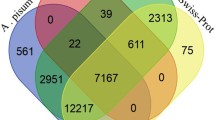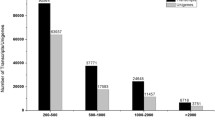Abstract
Didymium iridis is a model organism whose cell types can be triggered by environmental stimuli or artificial intervention. However, the mechanism of regulation of cell type transformation is still little known. In this study, the genes transcribed during four different ontogenetic stages of D. iridis were analyzed by high throughput sequencing. A total of 37,792 Unigenes was assembled in which 24,523 unigenes and were identified the differentially expressed genes (DEGs) among different group samples by variation expression analysis. The DEGs were mainly involved in the Gene Ontology classification, like cellular processes, metabolic processes, receptor activity, and nucleic acid binding transcription factor activity, developmental process and growth. The DEGs from our samples were significantly enriched in metabolic pathways, such as starch and sucrose metabolism, RNA polymerase, the MAPK signaling pathway and fatty acid metabolism. Seven novel genes related to development and growth regulation were found, whose expression patterns were consistent with the results of trranscriptome sequencing. These results add to the available genetic data of D. iridis and and to the further understanding of the developmental processes in complex life cycles.







Similar content being viewed by others
Abbreviations
- COG:
-
(Clusters of Orthologous Groups)
- DEGs:
-
(differentially expressed genes)
- FDR:
-
(false discovery rate)
- KEGG:
-
(Kyoto Encyclopedia of Genes and Genomes)
- GO:
-
(Gene Ontology)
- NR:
-
(non-redundant)
- RPKM:
-
(Reads per Kb per Million reads)
References
Aldrich HC, Carroll G (1971) Synaptonemal complexes and meiosis in Didymium iridis: a reinvestigation. Mycologia 63(2):308–316
Ashburner M, Ball CA, Blake JA et al (2000) Gene ontology: tool for the unification of biology. The gene ontology consortium. Nat Genet 25:25–29
Bailey J, Cook LJ, Kilmer-Barber R, Swanston E, Solnica-Krezel L, Lohman K, Dove WF, Dee J, Anderson RW (1999) Identification of three genes expressed primarily during development, in Physarum polycephalum. Arch Microbiol 172(6):364–376
Bernier F, Pallotta D, Lemieux G (1986a) Molecular cloning of mRNAs expressed specifically during spherulation of Physarum polycephalum. Biochim Biophys Acta 867(4):234
Bernier F, Seligy VL, Pallotta D, Lemieux G (1986b) Changes in gene expression during spherulation in Physarum polycephalu. Biochem Cell Biol 64(4):337–343
Clark J (1980a) Competition between Plasmodial-incompatibility phenotypes of the Myxomycete Didymium iridis. I. Paired plasmodia. Mycologia 72(2):312–321
Clark J (1980b) Competition between Plasmodial-incompatibility phenotypes of the Myxomycete Didymium iridis. II. Multiple-clone crosses. Mycologia 72(3):512–522
Clark J (1991) Didymium iridis mating systems: partial compatibility between mating series. Mycologia 83(2):210–213
Clark J, Lott T (1981) Aging in the acellular slime mold Didymium iridis: temperature and nutritional effects. Exp Mycol 5(4):369–372
Clark J, Stephenson SL, Landolt JC (2001) Biosystematics of the didymium iridis super species complex: additional isolates. Mycotaxon 79:447–454
Clark J, Haskins EF, Stephenson SL (2004) Culture and reproductive systems of 11 species of Mycetozoans. Mycologia 96:36–40
Collins OR (1963) Multiple alleles at the incompatibility locus in the myxomycete Didymium iridis. Am J Bot 50(5):477–480
Collins OR (1976) Heterothallism and homothallism: a study of 27 isolates of Didymium iridis, a true slime mold. Am J Bot 63(2):138–143
Collins OR (1979) Myxomycete biosystematics: some recent developments and future research opportunities. Bot Rev 45(2):145–201
Conesa A, Gotz S, Garcia-Gomez JM et al (2005) Blast2GO: a universal tool for annotation, visualization and analysis in functional genomics research. Bioinformatics 21:3674–3676
Feng C, Ming C, Xu CJ et al (2012) Transcriptomic analysis of Chinese bayberry (Myrica rubra) fruit development and ripening using RNA-Seq. BMC Genomics 13:1471–1486
Glöckner G, Golderer G, Werner Felmayer G (2008) A first glimpse at the transcriptome of Physarum polycephalum. BMC Genomics 9:1–11
Grabherr MG, Haas BJ, Yassour M et al (2011) Full-length transcriptome assembly from RNA-Seq data without a reference genome. Nat Biotechnol 29(7):644–652
Heidel AJ, Lawal HM, Felder M et al (2011) Phylogeny-wide analysis of social amoeba genomes highlights ancient origins for complex intercellular communication. Genome Res 21:1882–1891
Hendrickson PG, Silliker ME (2010a) RNA editing in six mitochondrial ribosomal protein genes of Didymium iridis. Curr Genet 56(3):203–213
Hendrickson PG, Silliker ME (2010b) RNA editing is absent in a single mitochondrial gene of Didymium iridis. Mycologia 102(6):1288–1294
Jiang SC, Zhang B, Li YS, Li Y (2016) Optimization of axenic culture conditions of Myxomycete Didymium iridis. Mycosystema 35(5):641–644
Johansen S, Vogt VM (1994) An intron in the nuclear ribosomal DNA of Didymium iridis codes for a group I ribozyme and a novel ribozyme that cooperate in self-splicing. Cell 76:725–734
Johansen S, Elde M, Vader A, Haugen P, Haugli K, Haugli F (1997) In vivo mobility of a group I twintron in nuclear ribosomal DNA of the myxomycete Didymium iridis. Mol Microbiol 24:737–745
Keller HW, Schoknecht JD (1989) Life cycle of a new annulate spored species of Didymium. Mycologia 81(2):248–265
Kopp D (2012) Assembly of the Didymium Iridis mitochondrial genome by genome walking. Thesis. department of Biological Science, DePaul University, http://via.library.depaul.edu/csh_etd/20
Kroneder R, Cashmore AR, Marwan W (1999) Phytochrome-induced expression of lig1, a homologue of the fission yeast cell-cycle checkpoint gene hus1, is associated with the developmental switch in Physarum polycephalum plasmodia. Curr Genet 36(1-2):86–93
Martel R, Tessier A, Pallotta D, Lemieux G (1988) Selective gene expression during sporulation of Physarum polycephalum. J Bacteriol 170(10):4784
Marwan W (2003) Theory of time-resolved somatic complementation and its use to explore the sporulation control network in Physarum polycephalum. Genetics 164(1):105
Marwan W, Sujatha A, Starostzik C (2005) Reconstructing the regulatory network controlling commitment and sporulation in Physarum polycephalum based on hierarchical Petri Net modelling and simulation. J Theor Biol 236(4):349–365
Materna SC, Marwan W (2005) Estimating the number of plasmids taken up by a eukaryotic cell during transfection and evidence that antisense RNA abolishes gene expression in Physarum polycephalum. Fems Microbiol Lett 243(1):29–35
Morozova O, Marra MA (2008) Applications of next-generation sequencing technologies in functional genomics. Genomics 92:255–264
Mortazavi A, Williams B, McCue K et al (2008) Mapping and quantifying mammalian transcriptomes by RNA-Seq. Nat Methods 5:621–626
Okuda S, Yamada T, Hamajima M, Itoh M, Katayama T, Bork P, Goto S, Kanehisa M (2008) KEGG atlas mapping for global analysis of metabolic pathways. Nucleic Acids Res 36:W423–W426
Pauline S, Israel B, Pat M et al (2015) The Physarum polycephalum genome reveals extensive use of prokaryotic two-component and metazoan-type tyrosine kinase signaling. Genome Biol Evol 8(1):109–125
Rätzel V, Ebeling B, Hoffmann XK, Tesmer J, Marwan W (2013) Physarum polycephalum mutants in the photocontrol of sporulation display altered patterns in the correlated expression of developmentally regulated genes. Develop Growth Differ 55(2):247–259
Rätzel V, Marwan W (2015) Gene expression kinetics in individual plasmodial cells reveal alternative programs of differential regulation during commitment and differentiation. Dev Growth Differ 57:408-420. https://doi.org/10.1111/dgd.12220
Rojas C, Zúñiga JM, Stephenson SL (2015) Ecological niche modeling of some Costa Rican myxomycetes. Curr Res Environ Appl Mycol 5:153–159
Scheer MA, Silliker ME (2006) Mitochondrial inheritance patterns in Didymium iridis are not influenced by stage of mating competency. Mycologia 98(1):51–56
Schreckenbach T, Werenskiold A K (1986) Gene expression during plasmodial differentiation[M]. The Molecular Biology of Physarum polycephalum. Springer, New York, pp 131–150
Sucgang R, Kuo A, Tian X et al (2011) Comparative genomics of the social amoebae Dictyostelium discoideum and Dictyostelium purpureum. Genome Biol 12:R20 http://genomebiology.com/2011/12/2/R20
Sujatha A, Balaji S, Devi R, Marwanb W (2005) Isolation of Physarum polycephalum, plasmodial mutants altered in sporulation by chemical mutagenesis of flagellates. Eur J Protistol 41(1):19–27
Sweeney GE, Watts DI, Tumock G (1987) Differential gene expression during the amoebal-plasmodial transition in Physarum. Nucleic Acids Res 15(3):933–945
Tang Y, Nielsen H, Masquida B, Gardner PP, Johansen SD (2014) Molecular characterization of a new member of the lariat capping twin-ribozyme introns. Mob DNA 5:25. https://doi.org/10.1186/1759-8753-5-25
Traphagen SJ (2010) RNA editing of 10 Didymium iridis mitochondrial genes and comparison with the homologous genes in Physarum polycephalum. RNA 16(4):828–838
Wang Z, Gerstein M, Snyder M (2009) RNA-Seq: a revolutionary tool for transcriptomics. Nat Rev Genet 10:57–63
Watkins RF, Gray MW (2008) Sampling gene diversity across the supergroup Amoebozoa: large EST data sets from Acanthamoeba castellanii, Hartmannella vermiformis, Physarum polycephalum, Hyperamoeba dachnaya and Hyperamoeba sp. Protist 159:269–281
Wilke A, Harrison T, Wilkening J et al (2012) The M5nr: a novel non-redundant database containing protein sequences and annotations from multiple sources and associated tools. BMC bioinformatics 13:141. https://doi.org/10.1186/1471-2105-13-141
Ye J, Fang L, Zheng H et al (2006) WEGO: a web tool for plotting GO annotations. Nucleic Acids Res 34:W293–W297
Yip V, Beekman M, Latty T (2014) Foraging strategies of the acellular slime moulds Didymium iridis and Didymium bahiense. Fungal Ecol 11:29–36
Acknowledgments
We thank the Beijing Genomics Institute at Shenzhen (BGI Shenzhen) for their assistance with sequencing, and also thank Meiping Zhang and Kangyu Wang analysis, or interpretation of data for the work.
Funding
Natural Science Foundation of China (NSFC) Grant 31770012.
Author information
Authors and Affiliations
Corresponding author
Ethics declarations
Conflict of interest
The authors declare that they have no competing interests.
Electronic supplementary material
Table S1
(DOCX 14 kb)
Rights and permissions
About this article
Cite this article
Jiang, S., Zhang, B., Li, Y. et al. De novo assembly and annotation of Didymium iridis transcriptome and identification of stage-specfic genes. Biologia 73, 393–402 (2018). https://doi.org/10.2478/s11756-018-0037-2
Received:
Accepted:
Published:
Issue Date:
DOI: https://doi.org/10.2478/s11756-018-0037-2




